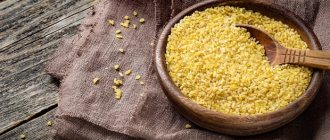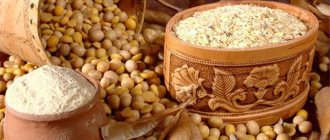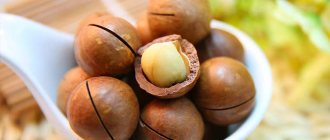- Duration 7 days
- Efficiency
2-6 kg - Difficulty
is low - Diet variety
is average - Rating
4.2 - Cost
up to 2000 rub.
When it comes to diet, it rarely occurs to anyone to use persimmon as a dietary product. Orange fruits are known by everyone for their sweet honey taste, and it would seem that the berries are least suitable for the diet. But don't be afraid to include it in your weight loss menu. And from the article you will find out why.
Description of the fruit
Persimmon is a fruit, or rather, it is a berry, the nutritional and medicinal properties of which were first appreciated by the inhabitants of China and Japan, where it comes from. Persimmon, shaped like a tomato, is a yellow-red fruit with a conical or slightly flattened shape. There are 4 leaves on the underside.
Persimmons are divided into varieties. Some fruits remain tart until fully ripe. The fruits can be of different colors - from light yellow-orange to dark red and orange-red.
Which one to choose?
Dried persimmons are not suitable for weight loss, as they are too high in calories. It should also be of the highest quality and ripe. Criterias of choice:
- The surface of the fruit is shiny and smooth.
- A light whitish coating is quite acceptable, it is of natural origin.
- Color - from dark orange to brown.
- The skin is thin, almost transparent, without damage or mold. Brown stripes indicate a sweet taste.
- The peduncle is dry, brown or brown in color.
- The base under the leaves is brown.
- The smell is fresh, but not sweet.
Varieties:
- “King” (Hiakume and the Chocolate Girl, or Zenji-Maru) - sweet and soft;
- "Chamomile" - sweet and impatient;
- “Fig” - delicate in taste;
- “Bull's Heart”, “Candle” - the most tart;
- “Persimon” - juicy, sweet;
- "Sharon" is a gentle, impatient hybrid.
All varieties can easily fit into a diet when losing weight.
Beneficial properties of persimmon for women, men and children
Persimmons are valued for their bioactive compounds, including: ascorbic acid (or vitamin C), carotenoids, polyphenols, plant fibers and minerals. Foods rich in polyphenols are valuable for human health due to their antioxidant properties.
Polyphenols and carotenoids are present in the highest concentrations in the peel of persimmons, which significantly contributes to the intense orange color of ripe fruits.

In Chinese medicine, these fruits have been used for centuries to treat snake bites and irritated skin. Persimmon leaves also contain numerous health benefits and are therefore used by the Chinese to treat various ailments. A drink made from boiled leaves is useful for lowering blood pressure, reducing blood clotting and treating tumors.
The beneficial properties of persimmon and contraindications for women and men indicate that it should be included in your healthy eating plan. Persimmon reduces total cholesterol, LDL, and triglycerides. Carotenoids contained in persimmons ensure normal functioning of vision, especially in the dark. Beta-carotene (provitamin A) is a component of the visual pigment found in the retina of the eye, which allows vision at dusk.
In addition, beta-carotene reduces the risk of developing macular degeneration, which is the main cause of vision loss in old age. It has also been shown that persimmon can prevent lens damage and cataract formation.

Can pregnant women eat persimmons?
The beneficial properties of persimmon allow it to be used in the diet of everyone, including pregnant women. It contains a large amount of vital nutrients, so it is recommended for women during pregnancy.
Persimmon is rich in calcium and phosphorus. Thus, systematic consumption of berries during such an important period for the fair sex promotes the active growth and development of the bones of the unborn baby. The fruit also promotes the normal functioning of neuronal cells in the central nervous system.
The iron content in persimmons helps prevent the risk of anemia during pregnancy. Periodic consumption of fruits makes it possible to increase hemoglobin levels. Among other things, this prevents the adverse effects of anemia, such as fatigue and dizziness that are characteristic of this condition.
Eating persimmons during pregnancy also helps to significantly strengthen the immune system. The content of vitamin A and carotene necessary for the eyes in the fruit helps strengthen vision and heart muscle, and also contributes to the smooth functioning of processes in the body. The vitamin C content in fruits significantly improves immunity.
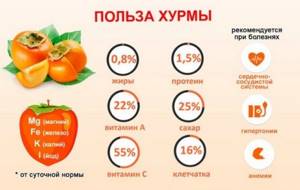
When can persimmons cause harm?
As for contraindications for women and men, in addition to the huge variety of beneficial properties of persimmon, it can also be harmful to health. If it is used uncontrollably and in unlimited quantities, it can worsen the condition in the presence of various types of diseases.
For diabetes mellitus, it is recommended to prepare compotes or jellies from it. You can also eat fruits together with others in the form of fruit salads, but in limited quantities. In case of hypotension, it is recommended to consume no more than one persimmon per day because it can further reduce blood pressure.
Persimmon consumed in large quantities can lead to constipation, especially if eaten before the main meal. If you are prone to allergies, the fruits should be consumed with great caution. If you are obese, it is recommended to replace persimmons with other berries or fruits.
How late should dinner be?
Persimmons will be a great addition to dinner, as they contain quite a lot of dietary fiber. But it is important to remember that dinner should be at least 3-4 hours before bedtime. Doctors advise eating no more than one piece of this delicacy at this time.
Do not forget that it is important to choose only ripe fruits . It is better not to take green or unripe fruits and, of course, not to eat them at night; this generally does not benefit the body, but can also cause harm. And especially if you have diseases of the gastrointestinal tract.
Strengthens or weakens the stool
Fans of persimmon are curious whether it weakens or strengthens the chair. Undoubtedly, with unlimited use, persimmon can soften stool. Due to the presence of fiber in the composition, it helps normalize intestinal function. Therefore, it is recommended for constipation.
Persimmon has the ability to stimulate intestinal functions. To normalize stool and restore stable bowel function, you should consume persimmon in moderation. It is better to eat only ripe berries.
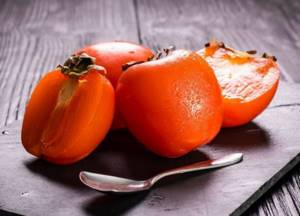
Kinds
Persimmons (the calorie content of a weight loss product is given below in the article) are divided into tart and non-tart types depending on their origin. Tart ones have a soft, jelly-like consistency, astringent until ripening due to the large amount of tannin they contain. Such fruits are used as food and used in making jam and preserves.

Impatient - characterized by high density, elasticity and are suitable for preparing salads and dried fruits.
There are 6 varieties of persimmon:
- Kinglet. The most popular variety, characterized by light orange or dark brown flesh and the presence of seeds. The color of the seeds changes immediately after pollination and signifies the acquisition of softness and maturity of the fruit.
- Chocolate girl. A wren-like variety with a thin skin and a pleasant yellow or chocolate-colored pulp. The weight of one fruit is 250 g. There are grains inside. The variety withstands temperature changes well.
- Fig or chamomile. An early, fig-like variety with a small, flower-like shape. The flesh of the fruit is dark, the peel is yellow-orange or dark orange. It has a high sucrose content.
- Honey. The shape of the fruit is similar to a tangerine, has a sugary sweetish taste of the pulp and a thick peel. It contains a lot of fruit sugar, acquiring, after ripening, a jelly-like structure, which makes transportation very difficult.
- Bull's Heart . The fruits are distinguished by their very large size, tomato-like shape and moderate viscosity. The peel of the fruit is thin and very soft, which makes it very difficult to transport. A distinctive feature is also a delicate, less sweetish taste than other varieties.
- Sharon . A variety created by crossing a persimmon with an apple. It has a small shape and a dense structure, even after ripening. The peel of the fruit is rich yellow or orange. The pulp is light, non-astringent and seedless.
- Persimon . Oriental, very sweet variety, sourced from a subtropical climate. It has a dark orange color, a dense, non-jelly structure and a pleasant, very sweet pulp without viscosity.
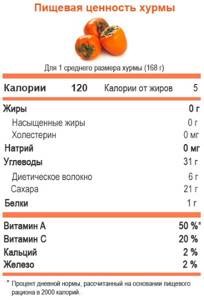
Calorie content and BJU indicators. The energy value of the fruit also varies depending on the variety.
| Variety | Calorie content |
| Kinglet | 76 kcal (66 per 100 g.) |
| Chocolate girl | 112 kcal (67 per 100 g) |
| Sharon | 135 kcal (69 per 100 g) |
| Bull's heart | 235 kcal (68 per 100 g) |
| Honey | 242 kcal (67 per 100 g) |
| Fig | 263 kcal (72 per 100 g) |
| Kaki | 302 kcal (67 per 100 g.) |
Calorie content of persimmons and is it possible to eat them while losing weight?
The unique beneficial properties and calorie content of persimmon make it possible to include it in the menu for people who want to be slim. Energy value is 70 kcal per 100 g. Thus, it can be included in the diet even if you are on a diet. Persimmon not only helps you avoid gaining weight, but also helps cope with obesity.
Due to the high fiber content, the body quickly satiates; the person consuming it effectively satisfies hunger, which allows you not to overeat and remain slim. Therefore, persimmon should be used by people who want to lose weight and control their diet. There are many persimmon-based diets. Once a week you can eat exclusively persimmons, eating 5-6 berries per day.
Menu for the week
| Day of the week | Eating | Menu for the day |
| Monday | Breakfast | glass of kefir, 1 king |
| Lunch | green tea | |
| Dinner | boiled chicken breast, vegetable salad | |
| Afternoon snack | 1 king | |
| Dinner | a glass of natural yogurt | |
| Tuesday | Breakfast | oatmeal with water, black coffee without sugar |
| Lunch | 1 persimmon | |
| Dinner | buckwheat soup, 1 king | |
| Afternoon snack | low-fat cottage cheese with fruits | |
| Dinner | vegetable salad | |
| Wednesday | Breakfast | yogurt, 1 persimmon |
| Lunch | 1 boiled egg, 1 glass of tomato juice | |
| Dinner | stewed vegetables with chicken | |
| Afternoon snack | 1 king | |
| Dinner | glass of kefir, fruit salad | |
| Thursday | Breakfast | omelette, cup of green tea |
| Lunch | 1 persimmon | |
| Dinner | lean borscht, any fruit of your choice | |
| Afternoon snack | 1 persimmon | |
| Dinner | fruit salad with yogurt | |
| Friday | Breakfast | oatmeal with water and dried fruits |
| Lunch | 1 persimmon | |
| Dinner | 2 steamed chicken cutlets, vegetable salad | |
| Afternoon snack | 1 persimmon | |
| Dinner | a glass of kefir, 2 pieces of hard cheese | |
| Saturday | Breakfast | 2 boiled eggs, vegetable salad, |
| Lunch | 1 persimmon | |
| Dinner | vegetable salad, boiled chicken breast | |
| Afternoon snack | 1 persimmon | |
| Dinner | glass of kefir | |
| Sunday | Breakfast | green tea, 1 persimmon |
| Lunch | 1 fruit of your choice | |
| Dinner | soup with boiled chicken meat, cucumber salad | |
| Afternoon snack | 1 persimmon | |
| Dinner | glass of kefir |
Positive reviews about this diet prove that the result is achieved very quickly and easily. The main thing is to monitor the caloric content and amount of food consumed during the weight loss process.
Please note: It is also worth remembering that exiting this diet should be gradual, without a sudden breakdown in buns, chocolates, etc.
For the right way out, it is enough to gradually expand your diet, but so that its calorie content does not exceed 2000 kcal. You can add 1 new product per day. It is best to focus on adding cereals, hard cheeses, whole grain bread, vegetable oil, nuts, and dried fruits to your diet.
Recommended video: How to choose persimmons
Video





